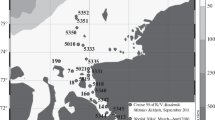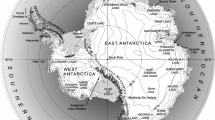Summary
Amos Lake is a shallow, permanently cold, maritime Antarctic lake which is almost totally anoxic for much of the 9 month period of winter ice cover each year. The lake catchment is a source of considerable nutrient enrichment for the lake due to the presence, in summer, of large numbers of seals and seabirds. A dense growth of phytoplankton was supported by this enrichment and, in turn, was a source of nutrients for the diverse microflora of the lake. The phytoplankton had a very high assimilation efficiency and an apparent high tolerance of anoxia. Bacterioplankton numbers and activity were closely linked to algal activity and both groups showed a strong seasonality typical of polar systems. Anaerobic bacteria (notably sulphate reducers and methanogens) were not as significant as anticipated, being largely restricted to the deeper lake trough region and possibly subject to substrate limitation later in the anoxic period. The results are discussed in the context of previous findings for other maritime Antarctic lakes.
Similar content being viewed by others
References
Abd-el-Malek Y, Rizk SG (1958) Counting of sulphate-reducing bacteria in mixed bacterial populations. Nature 182:538
Dawson FH (1981) An inexpensive photosynthetic irradiance sensor for ecological field studies. Hydrobiologia 77:71–76
Ellis-Evans JC (1981a) Freshwater microbiology in the Antarctic. 1. Microbial numbers and activity in oligotrophic Moss Lake. Br Antaret Surv Bull 54:85–104
Ellis-Evans JC (1981b) Freshwater microbiology in the Antarctic. 2. Microbial numbers and activity in nutrient-enriched Heywood Lake. Br Antaret Surv Bull 54:105–121
Ellis-Evans JC (1981c) Freshwater microbiology of Signy Island, South Orkney Islands, Antarctica. Ph D thesis, CNAA (unpublished)
Ellis-Evans JC (1982) Seasonal microbial activity in Antarctic freshwater sediments. Polar Biol 1:129–140
Ellis-Evans JC (1984) Methane in maritime Antarctic freshwater lakes. Polar Biol 2:115–126
Ellis-Evans JC, Wynn-Williams DD (1985) The interaction of soil and lake microflora at Signy Island. In: Siegfried WR, Laws RM, Condy PR (eds) Antarctic nutrient cycles and food webs. Proc 4th SCAR Symp Antarct Biol, Wilderness, September 1983. Springer, Berlin, pp 662–668
Gallagher JB (1985) The influence of iron and manganese on nutrient cycling in shallow freshwater Antarctic lakes. In: Siegfried WR, Laws RM, Condy PR (eds) Antarctic nutrient cycles and food webs. Proc 4th SCAR Symp Antarct Biol, Wilderness, September 1983. Springer, Berlin, pp 234–237
Gardner WD (1980) Field assessment of sediment traps. J Mar Res 38:41–52
Goldman CR, Mason DT, Wood BJB (1972) Comparative study of the limnology of two small lakes on Ross Island, Antarctica. In: Llano GE (ed) Antarctic terrestrial biology, vol 20. American Geophysical Union Antarctic Series, Washington, pp 1–50
Golterman HL, Clymo RS, Ohnstad MAM (1978) Methods for physical and chemical analyses of freshwaters. IBP Handbook 8. Blackwell, Oxford
Hawes I (1983) Nutrients and their effects on phytoplankton populations in lakes on Signy Island, Antarctica. Polar Biol 2:115–126
Hawes I (1985) Factors controlling phytoplankton populations in maritime Antarctic lakes. In: Siegfried WR, Laws RM, Condy PR (eds) Antarctic nutrient cycles and food webs. Proc 4th SCAR Symp Antarct Biol, Wilderness, September 1983. Springer, Berlin, pp 245–252
Hawthorn GR, Ellis-Evans JC (1984) Benthic protozoa from maritime Antarctic lakes and pools. Br Antarct Surv Bull 62:67–81
Heywood RB, Dartnall HJG, Priddle J (1979) The freshwater lakes of Signy Island, South Orkney Islands, Antarctica: Data sheets. Br Antarct Surv data no 3, 46 pp
Heywood RB, Dartnall HJG, Priddle J (1980) Characteristics and classification of the lakes of Signy Island, South Orkney Islands, Antarctica. Freshwater Biol 10:47–59
Hobbie JE, Crawford CC (1969) Respiration corrections for bacteria uptake of dissolved organic compounds in natural waters. Limnol Oceanogr 14:528–532
Hoppe H-G (1976) Determination and properties of actively metabolizing heterotrophic bacteria in the sea, investigated by means of microautoradiography. Mar Biol 36:291–302
Jones JG (1971) Studies on freshwater bacteria: factors which influence the population and its activity. J Ecol 59:593–613
Light JJ (1977) Production and periodicity of Antarctic freshwater phytoplankton. In: Llano GE (ed) Adaptations within Antarctic ecosystems. Proc 3rd SCAR Symp Antarct Biol Washington, September 1974. Smithsonian, Washington DC, pp 829–837
Light JJ, Ellis-Evans JC, Priddle J (1981) Phytoplankton ecology in an Antarctic lake. Freshwater Biol 11:11–26
Lovell CR, Knonpka A (1985) Seasonal bacterial production in a dimictic lake as measured by increases in cell numbers and thymidine incorporation. Appl Environ Microbiol 49:492–500
Priddle J, Hawes I, Ellis-Evans JC, Smith TJ (1986) Antarctic aquatic ecosystems as habitats for phytoplankton. Biol Rev 61:199–238
Skerman VBD (1967) A guide to the identification of the genera of bacteria. Williams and Wilkins, Baltimore
Spencer MJ, Ramsay AJ (1978) Bacterial populations, heterotrophic potentials, and water quality in three New Zealand rivers. NZ J Mar Freshwater Res 12:415–427
Vollenweider RA (1969) A manual on methods for measuring primary production in aquatic environments. IBP Handbook 12. Blackwell, Oxford
Author information
Authors and Affiliations
Rights and permissions
About this article
Cite this article
Ellis-Evans, J.C., Sanders, M.W. Observations on microbial activity in a seasonally anoxic, nutrient-enriched maritime Antarctic lake. Polar Biol 8, 311–318 (1988). https://doi.org/10.1007/BF00263180
Received:
Accepted:
Issue Date:
DOI: https://doi.org/10.1007/BF00263180




